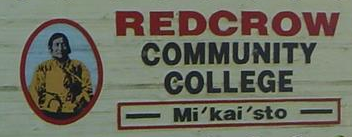Saokiipisatsiinikimm – Allium cernuum (Prairie Funny Vine)
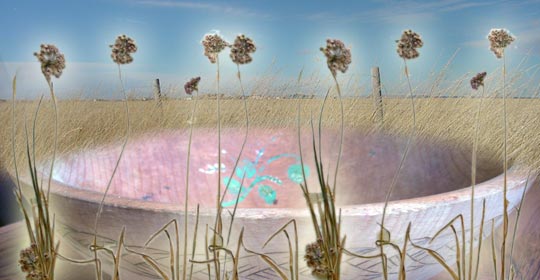
This wooden bowl was decorated by Reo Hairy Bull. You can eat the Nodding Onion raw and use it in cooking for flavor. It tastes like onion and garlic, both.
Saokiipisatsiinikimm
Saokiipisatsiinikimm akohkotohtsipotsima’so’p. Iitaisaisskssoyiiyaw saokioohtsi. Iikakawoyi niipistsi, aisaissksiimokoyaw ki pisatssaisskiistsi aiksiksinattsiyaw. Iikanistainattsi saokiipisatsiinikimm annii aisapi’tsohkiawaniw. Ihpaoyo’oso’p,, ihtaiksistsikimisstao’p, ki matohtaotoitsikato’p akito’mikinaso’p.
Nodding Onion
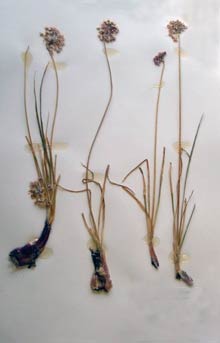
Allium cernuum
Galileo Educational Network
*WARNING: Nodding Onion can look like Death Camas when first growing. They both grow in the same areas. Nodding onion has a distinct onion odor. A mistake could be fatal.
Nodding Onion is also known as Prairie Funny Vine. It grows at the edges of scrubby patches and on the open prairie. It has lots of medium, green, narrow, circular leaves and the flowers are white to pinkish purple. The tiny lily shaped flowers are about 6 mm long and they grow in a nodding cluster of 8 to 12. When the flower is in bloom in June to August, the plant looks like it is nodding and it looks a little funny to see it shake its head up and down in the breeze. The whole plant is 10-40 cm tall.
You can eat the Nodding Onion raw and use it in cooking for flavor. It tastes like onion and garlic, both.
If you crush the stem and breath it in, it helps to unplug your nose. The plant with the flowers can be dried and then brewed up into a tea. Drink this tea if you have pains in your abdomen. To reduce swelling from a sprain, soak some cloths in the tea and put them onto the swollen area.
Ail penché
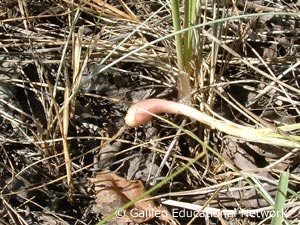
Allium cernuum
Galileo Educational Network
*AVERTISSEMENT : L’ail penché peut ressembler au camas mortel quand il commence à pousser. Ces deux plantes poussent dans les mêmes endroits. L’ail penché a une odeur d’ail distincte. Une erreur pourrait être fatale.
L’ail penché pousse le long des broussailles ou dans la prairie claire. Il a beaucoup de feuilles vertes de forme circulaire et étroite, de taille moyenne. La couleur de ses fleurs varie de blanche à rose pourpre. Ses miniscules fleurs en forme de lys mesurent environ 6 millimètres de long. Elles poussent en grappes penchées composées de 8 à 12 fleurs. Quand cette plante fleurit de juin à août, elle donne l’impression d’être penchée. C’est drôle de la voir se branler la tête de haut en bas au vent. Cette plante mesure de 10 à 40 centimètres de haut.
L’ail penché peut être mangé cru ou encore, nous pouvons nous en servir pour rehausser la saveur des plats cuisinés. Il a un goût d’ail et d’oignon.
Si nous en écrasons la tige et la respirons, cela nous aide à décongestionner le nez bouché. Cette plante, y compris ses fleurs, peut être séchée et infusée pour en faire du thé. Ce thé soulage les douleurs abdominales. Aussi, pour réduire les douleurs associées aux entorses, nous pouvons faire tremper des morceaux de tissu dans le thé et les placer sur les membres enflés.
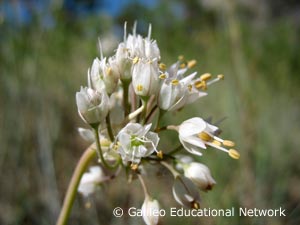
Allium cernuum
Galileo Educational Network
- Kerik, Joan. (1979). Living With The Land: Use of Plants by the Native People Of Alberta. Edmonton, Alberta: Provincial Museum of Alberta.
- Vance, F.R., Jowsley, J.R. & Mclean, J.S. (1984). Wildflowers Across The Prairies. Saskatoon, Saskatchewan: Western Producer Prairie Books.
- Willard, Terry. (1992). Edible and Medicinal Plants of the Rocky Mountains and Neighboring Territories. Calgary, Alberta: Wildrose College of Natural Healing.



